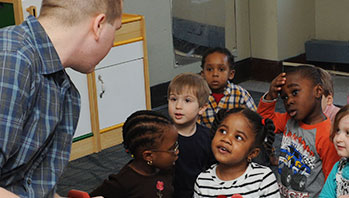- basket of a variety of objects of different sizes, shapes, and textures (e.g., rubber ball, eraser, marble, chalkboard eraser, pen cap, cloth doll, etc.)
- bubble wrap
- cardboard
- fabric
- paper
- sandpaper
- material
- surface
- texture
MA Standards:
Speaking and Listening/SL.PK.MA.1: Participate in collaborative conversations with diverse partners during daily routines and play.
Language/L.PK.MA.1: Demonstrate use of oral language in informal everyday activities.
Language/L.PK.MA.6: Use words and phrases acquired through conversations, listening to books read aloud, activities, and play.
Head Start Outcomes:
Language Development/Receptive Language: Attends to language during conversations, songs, stories, or other learning experiences.
Language Development/Expressive Language: Uses language to express ideas and needs.
PreK Learning Guidelines:
English Language Arts/Language 2: Participate actively in discussions, listen to the ideas of others, and ask and answer relevant questions.
Talk Together: How Does It Feel?

© Commonwealth of Massachusetts, Department of Early Education and Care (Jennifer Waddell photographer). All rights reserved.
STEM Key Concepts: The motion and speed of a rolling or sliding object is affected by the texture of the object and the texture of the surface on which it is rolling or sliding
ELA Focus Skills: Compare and Contrast, Speaking and Listening, Vocabulary
Display the following items: a sheet of sandpaper, a piece of bubble wrap, a piece of cardboard, a piece of fabric, and a sheet of paper.
- Have children take turns feeling each item.
- Introduce the word texture and describe it as “the way something feels when you touch it.”
- Talk about how each texture feels. Ask children to describe how the materials feel different or the same.
Now, pass around the basket of objects and have each child choose one object. Talk with children about how the outside, or surface, of each object feels. Have each child hold up the object he or she chose and describe how it feels. Ask questions to help them describe their object, such as,
- Josh, does the texture of the chalkboard eraser feel like any of the items you felt this morning? How is it the same? Different?
- How is the texture of the eraser different from the texture of the marble that Sophia chose?
Encourage children to use content vocabulary and made-up words to describe the texture of their objects. Guide them to use full sentences such as, “The stick has a rough, prickly texture.”
Tell children that they will be exploring how the texture of an object can affect the motion and speed of a rolling or sliding object.
